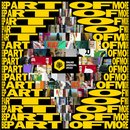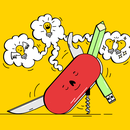Become an Art Director
Tips on how to land a job as an art director from working art directors

Art directors are visual storytellers who create the overall style of a product. You’ll find them within most creative industries – in publishing, advertising, on film sets and at just about any company that needs to communicate visually. Whether they’re creating the visual style themselves, or directing someone else, having a great eye for design is key to being a great art director. This is why it’s usually standard practice for people in this role to have a background in the visual arts, including photography, illustration, filmmaking and graphic design, amongst others. As an art director, you’ll need to come up with the visual language for a project, articulate your ideas to your team, and then execute your creative vision to make the finished product – be it a film, ad, magazine or book cover. This is not an easy job, and requires innovative leaders with multi-disciplinary skill sets. We spoke to five art directors from various creative companies to get their tips on how to succeed as an art director or as we like to say, the captain of a visual team.
Focus on your craft
Art directors will always have technical skills themselves. You’re probably here because you’re already an artist. Whether you’re a designer, illustrator or photographer, the first step you can take to becoming an art director is to focus on your craft. Anna Jay, Art Director at Refinery29 says, “I had no idea about art direction when graduating (from Photography in 2012), I knew I wanted to work in photography and did freelance work at different publishers before going full time in a photo editor role. Design came second for me, and has become something synonymous with my photography background. My advice would be just to follow what you enjoy doing and not a pathway leading you to a certain title or job role.”
Jacob Lindell, Art Director at Superunion has similar advice, and also points out that practicing your craft will help you generate better ideas saying, “Practice your craft. Sketch, sketch, sketch and sketch some more. The faster you can communicate your ideas the faster you’ll get to a good idea.”
Focussing on your craft instead of on the title will get you far, and in doing what you love and being good at it, you’re more likely to be promoted to art director. Nicole Caputo, Creative Director/Art Director at Catapult/Counterpoint Press says, “I started as a junior designer and worked my way up over the years to art director and then to creative director.”
Put your work out there
Practicing your work will mean little in landing a job unless people see what you’re creating. Amy McGowan, Junior Art Director at Wunderman Thompson says, “my advice for getting a job is to get yourself out there as much as possible. Seems obvious but turn up to every event, go to every talk and workshop, keep emailing creatives and keep posting your work online. Make yourself easy to find.”
McGowan says she got her first internship by being the only person who turned up, and got her first permanent job from being scouted when exhibiting her work. She says, “I am a big believer in finding opportunities and staying hungry even when things are feeling rather slow.”
Making a website to showcase your work is a good place to start. Then send your portfolio to people you admire and see where it goes.
Partner with a talented wordsmith
Art direction and copywriting go hand in hand and very rarely can you have one without the other. Getting a partner to bounce ideas off is always a good way to stimulate your creativity. Lindell says, “when the opportunity to partner with a copywriter presented itself, I took it with both hands. Having a creative sparring partner and the shift to a words-first design process opened up a whole new world for me creatively, and I ended up transitioning full time into the art director role.”
As an art director, you’ll have to work collaboratively, and there’s no better time to start than the present. Lindell continues, “Having a creative partner is wonderful and one with complementary ability is invaluable. It challenges you to think in new ways and opens up new horizons.”
Plus, having a partner will help you grow your conceptual skills. McGowan, who met her creative partner while studying advertising at University in London and says, “We concept ideas together for brands and I help to visually bring these to life.”
Never stop learning
Art directors are leaders in their field and true leaders never stop learning. Jacqui J. Sze, Senior Art Director at Aesop says, “I serendipitously fell into the path of art direction by having an insatiable thirst to learn new ways of expression; and along the way, developing a meticulous eye for detail.”
Always learning new things will also make you multi-disciplinary and Sze continues, “Being multidisciplinary only makes you a stronger creative, so stay humble and never stop learning something new.”
Jay has very similar advice and says,“The creative landscape is broad, with skills and disciplines all crossing over so try not to limit yourself to one thing, and always remain nimble to new challenges.” The more knowledge you have, the easier it’ll be to make your creative visions come true.
Learn how to give direction
Art directors don’t always execute their own ideas. In this role, you’ll have to learn how to hire the right type of talent for a particular job and then guide them on how to do their best. Providing direction is a skill, and to do it well you’ll have to learn how to get your point across.
In this sense, art direction is about convincing people of your vision, and Caputo says, “Learn how to talk about your work and be able to provide the reasons why you have made certain design decisions. This will help you guide other designers. Every decision should be backed by reason.” Sharpen your reasoning skills by thinking about every piece of work you’ve produced. Why did you take the direction you did?
Don’t lose your love for art
Art direction is a creative profession that people usually go into out of pure love for their craft. When corporate life or money comes into play, it’s easy to forget why you started in the first place. McGowan says, “When you turn your hobby of being creative into a job it can be easy to lose your love and motivation for it. My piece of advice would be to stay creative outside of your job to help keep you inspired. Maybe you love printing, crafting or painting, whatever it is, still make time for it outside the 9-5.”
Similarly Joy says, “stop and move on if it ever gets boring.” After all, you’re in it to make art and have some fun along the way.
Get more advice and tips from professional creatives and learn how you can land the creative job of your dreams.
Sign up now



